ISSN ONLINE(2319-8753)PRINT(2347-6710)
ISSN ONLINE(2319-8753)PRINT(2347-6710)
Saleh I. Khassaf1 , Saja Sadeq Shakir2
|
| Related article at Pubmed, Scholar Google |
Visit for more related articles at International Journal of Innovative Research in Science, Engineering and Technology
The hydraulic bridges are one of the important structures that must be protected from the failure by continuous monitoring. Hence, this study is about the most common causes of bridges failure which is the local scour. In this research Hydrologic Engineering Center River Analysis System (HEC-RAS) program will be used to evaluate local scour around group piers of Babil Bridge in the middle of Iraq. It was found that the HEC-RAS model is a good tool for predicting local scour depth for bridge piers. Where found that the computed scour depth from HEC-RAS program compares well with the observed value. The local scour depth at group piers of Babil Bridge were calculated and found that the piers of the bridge are safe against scouring in the present time because the depth of the maximum local scour is less than the depth of foundation of the bridge.
Keywords |
| Babil Bridge, group piers, scour, local scour. |
INTRODUCTION |
| Bridges at river crossings are critical structures that require a substantial investment to construct and has an important role in economic development. The major damage to these bridges that occurs during floods. This damage is caused by various reasons. The main reason is the local scour at bridge foundations, namely piers and abutments. The scour can be defined as the lowering of the level of the riverbed by water erosion such that is a tendency to expose the foundations of a bridge (Melville and Coleman, 2000). The history of bridges hydraulics is replete with incidents of failed bridges whose design did not adequately account for the capacity of alluvial rivers to erode, or scour, channel beds and banks. Images of undermined piers, undercut abutments, and washed-out bridge approaches have haunted bridge engineer since antiquity. Investigators have used several ways and gave various of equations for estimation the depth and pattern of scour around piers. In this study, provide a description of the methodology used to develop the hydraulic model of Babil Bridge in Al-Hilla city in Iraq. The hydraulic modeling was performed using the one-dimensional U.S. Army Corps of Engineers Hydrologic Engineering Center River Analysis System, HEC-RAS version (4.1.0, 2010). Babil Bridge model was developed to evaluate the maximum local scour depth which formed around its group piers. |
II. SITE DESCRIPTION |
| BABIL BRIDGE WHICH IS CALLED BAB AL-HUSSAIN BRIDGE, THE BRIDGE WAS BUILT AT AL-HILLA CITY. IT CONSISTS OF THREE OPENINGS SEPARATED BY TWO PIERS (GROUP OF CYLINDERS) WHERE EACH PIER CONTAINS TWO COLUMNS AND ELEVEN ROWS, THE TOTAL LENGTH OF THE BRIDGE IS 64.35 M. THE DIAMETER OF EACH CYLINDER IS 80 CM, THE SPACING BETWEEN PIERS (S) IS 1.40 M AND THE MIDDLE SPACE BETWEEN THE TWO PIERS EQUAL TO 26.87 M. THE ABUTMENT OF THE BRIDGE WAS BUILT IN THE SECTION OF THE RIVER. FIGURE (1) SHOWS BABIL BRIDGE. |
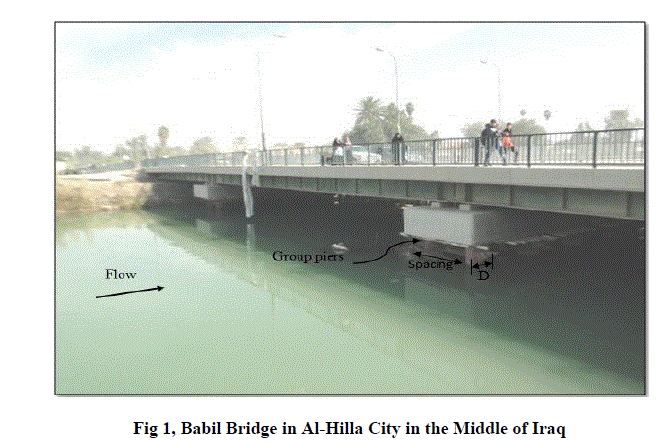 |
III. FIELD DATA MEASUREMENTS |
| The field work are bed material sampling and the collected geometric data for the bridge. The bed material sampling was done by taking three samples from the bed material of the section near piers, at the location of 0.25, 0.5 and 0.75 the width of the river in the cross section in order to conduct the grain size analysis. These samples finally mixed well to reduce the error of measurement and get a homogenous sample. The cross section data are obtained from Babil Water Resources Directorate (BWRD). |
IV. LABORATORY MEASUREMENTS |
| It involves collecting of laboratory data including measurements of A- specific gravity B- Mechanical analysis of the bed sample from which the size distribution curve can be constructed. Where the experiments was conducted in the laboratories Faculty of Engineering at University of Kufa. The calculations showed that the specific gravity which its value equal to (2.7) and mechanical analysis of the bed sample from which the size distribution curve can be constructed which was found from sieve analysis and shown in figure (2), where the value of d50 is equal to (0.19) and d95 is equal to (0.29). |
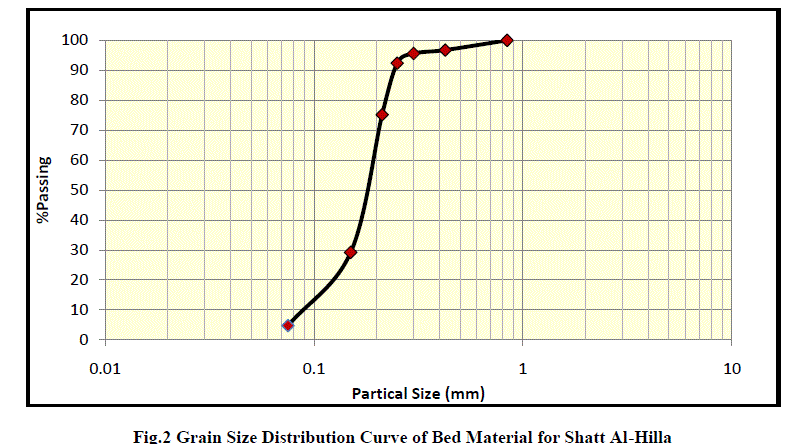 |
V. THE EFFECTIVE WIDTH OF THE PIER |
| For determining the local scour around group piers in HEC-RAS program by applying the equation of HEC-18, it should use the effective width of group piers (a*pg). Where it is the product of the projected width of the piers onto a plane normal to the flow multiplied by a spacing factor and a number of aligned rows factor. Figures (3) and (4) show the pier of Babil Bridge. a*pg = aproj Ksp Km (1) Where: a*pg is the effective width of group piers, aproj is sum of the non-overlapping projected widths of piers, Ksp is coefficient for pier spacing as shown in figure (5), Km is coefficient for the number of aligned rows (m) as shown in figure (6). Note that Km is constant for all S/a values when there are more than six rows of piers and Km is equal to (1.0) for skewed or staggered group piers and S is spacing between piers. (Richardson and Davis, 2001; Ataie-Ashtiani and Beheshti, 2006). For Babil Bridge, a = 80 cm, aproj = 160 cm, S = 140 cm and Ksp= 0.816 see figure (5), m = 11(number of rows) and Km = 1.21 see figure (6), then equation (1) is used to find that the effective width of group piers a*pg= 1.58 m. |
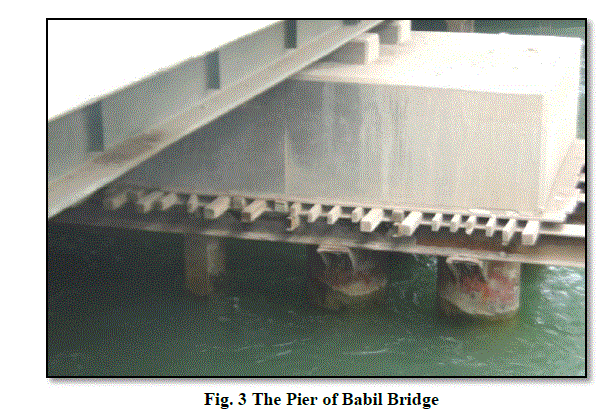 |
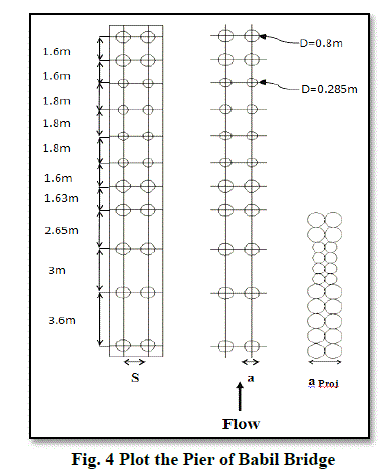 |
VI. BABIL BRIDGE SCOUR MODELING IN HEC-RAS PROGRAM |
| For this study, hydraulic model was developed using HEC-RAS [Version 4.1.0,(2010)]. The HEC-RAS model allows to perform simulation steady and unsteady flow evaluation in single or networked channels. It is an integrated system of software, designed for interactive use in multitasking, multi-user network environment. The system is comprised of a graphical user interface (GUI), separate hydraulic analysis components, data storage and management graphics and reporting facilities (HEC-RAS, 2010). Figure (7) showing the main window when you first start HEC-RAS model. |
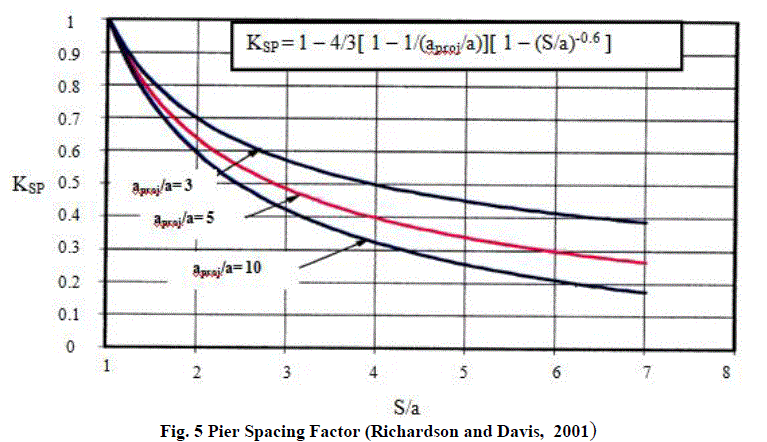 |
| To apply a bridge for a steady flow hydraulic model and to find the magnitude of maximum scour at bridge piers, two necessary file types are required: 1) The geometry file contains the necessary physical description for the stream reach and the bridge. 2) The flow file describes all the flow inputs and relates reach boundary conditions needed for the steady flow analyses. The data required to represent the bridge model are roadway data, piers data and sloping abutment data, these data were measured. For steady flow hydraulic model are flow regime, boundary conditions and peak discharge information are taken from Babylon Water Resources Directorate (BWRD). From these data, the model is applied using HEC-RAS one dimensional analysis to calculate the maximum scour at bridge piers. All the input data required to run a bridge HEC-RAS model are presented in the following sections. |
VII. THE GEOMETRIC DATA |
| The first step to develop HEC-RAS model is to create a HEC-RAS geometric file. The basic geometric data consists of establishing how the various river reaches are connected (River System Schematic); cross section data; reach lengths; energy loss coefficients (function losses, contraction and expansion losses); and stream junction information. These data were inputted to the model through the menu of cross section geometrical data as shown in figure (8). Whereas, the bridge location on the river is specified and its detail has entered to the model using bridge geometrical data menu, as shown in figure (9). |
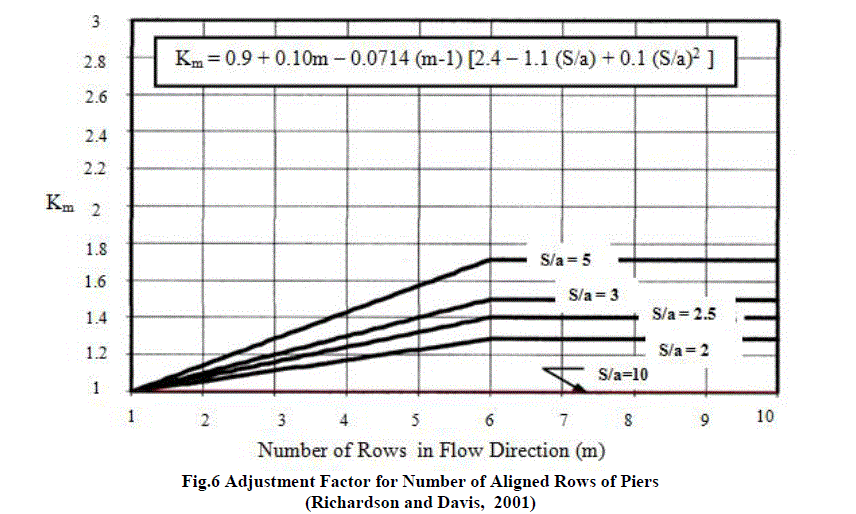 |
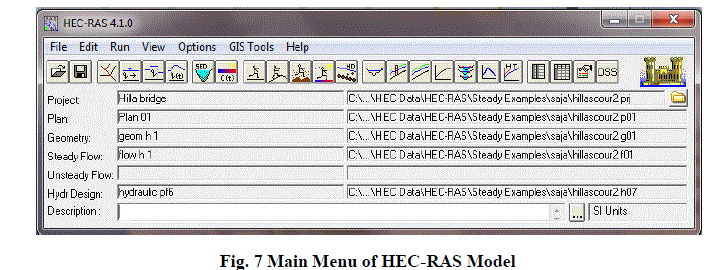 |
VIII. THE RIVER SYSTEM SCHEMATIC |
| The schematic defines how the various river reaches are connected. The model can handle simple single reach modules or complex networks. The river system schematic is developed by drawing and connecting the various reaches of the system within the geometric data editor. This schematic data must be the first input into the HEC-RAS model. For this study, the model of river system schematic is single reach. A schematic diagram of the river system is drawn as shown in Figure (9). The reach is drawn from upstream to downstream (in the flow direction), because the HEC-RAS model assumes this to be true. |
IX. CROSS SECTION GEOMETRY |
| Boundary geometry for the analysis the flow in river stream is specified in terms of ground surface profiles (cross sections) .The measured distance between any two cross sections is referred to a reach length. Cross sections should be perpendicular to the anticipated flow lines and extend across the entire flood plain (these cross sections may be curved or bent). The cross section is described by entering the stations and their elevations (x-y) data from left to right. When numbering River Station Identifiers were being taken; it was assumed that the higher numbers are upstream and the lower numbers are downstream within a reach. All of the required information is displayed on the cross section data editor, figure (10) shows some of cross sections at upstream and downstream. |
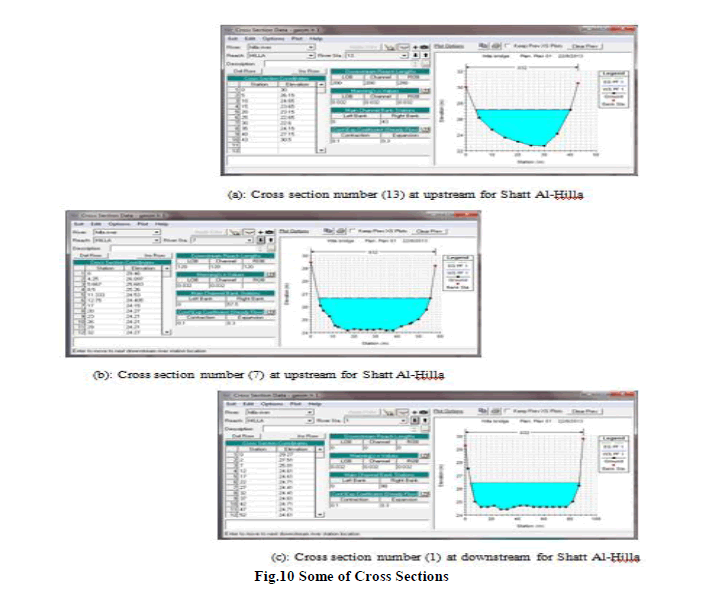 |
X . ENERGY LOSS COEFFICIENTS |
| Energy losses are represented by channel expansion, contraction and by friction losses. Explaining these losses are in the following sections. Manning’s Coefficient (n) The value of n depends on: surface roughness, vegetation, channel irregularities, channel alignment, scour and deposition, obstructions, size and shape of the channel, stage and discharge, seasonal change, temperature, and suspended material and bed load (Chow, 1959; Henderson, 1966). One value of (n) will be selected for all cross sections as shown in figure (10), for the reach in this study Manning’s coefficient was taken 0.032 (Othman, 2006). Contraction and Expansion Coefficients Contraction or expansion of flow due to changes in the cross section is a cause of energy loss between cross sections. The loss may be computed from the contraction and expansion coefficients were input manually using the HEC-RAS cross section data editor, figure (10). Typical coefficients used in the model are values 0.1 and 0.3 for Contraction and Expansion Coefficients, respectively. |
XI. BRIDGE GEOMETRY |
| Bridge geometry consists of the necessary data that related to the bridge: The location of the bridge by entering new river station for the bridge in the reach. Roadway data that include the distance between the upstream cross section and bridge, the width of bridge in direction of flow and the thickness of bridge is described by entering the stations and elevations of bridge (x-y) data from left to right. Pier data that include the distance from the left to the centerline of each pier, the width of the pier and the height of the pier represented by elevations. These data are entered to the model through the menu of bridge data as shown in figure (11). |
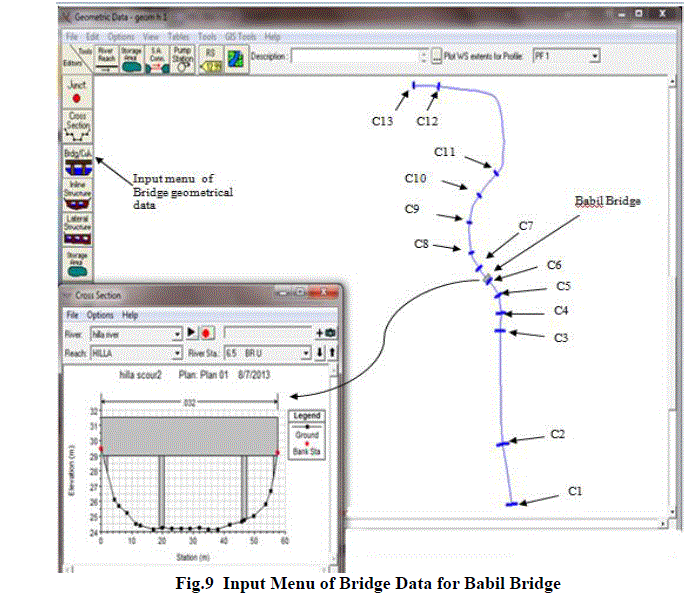 |
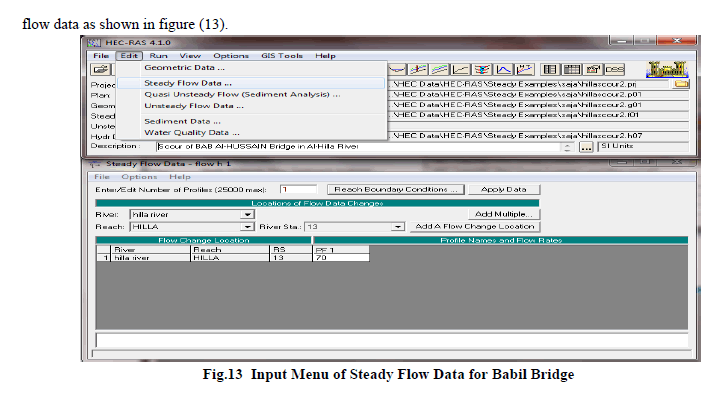 |
XII. BABIL BRIDGE SCOUR |
| For Babil Bridge the data that required to be entered are a d50 size fraction for the bed material which is equal to (0.19 mm) from the grain size distribution curve of bed material. The correction factor of pier nose shape (K1) which is equal to (1) for round nose, the correction factor of angle of attack for flow hitting the piers (K2) which is determined by entering the angle of attack, the correction factor of condition of the bed (K3) and a d95 size fraction for the bed material which is equal to (0.29 mm). To determine whether the flow condition is either clear-water or live-bed, the channel velocity (V1) which equal to (0.68 m/s) as shown in figure (14) is compared to the critical velocity of the d50 size for sediment movement (Vc) by using this formula : Vc = 6.19 (y1)1/6 (D50)1/3 (2) The found value for Vc is (0.39 m/s), henceV1>Vc, that means the flow condition is live-bed (Richardson and Davis, 2001; Barbhuiya and Dey, 2004), therefore selected plane bed and anti-dunes in bridge scour window. The result of scour at piers can be computed from this window which appears at the figure (14), the scour for this case is equal to (1.68 m). From field measurements, the maximum scour depth that measured was equal to (1.43 m) and the computed scour from HEC-RAS program is (1.68 m) that is a good indicator. Through the results showed that the bridge is safely against the scour, this is because the scour depth is fewer than footing depth. |
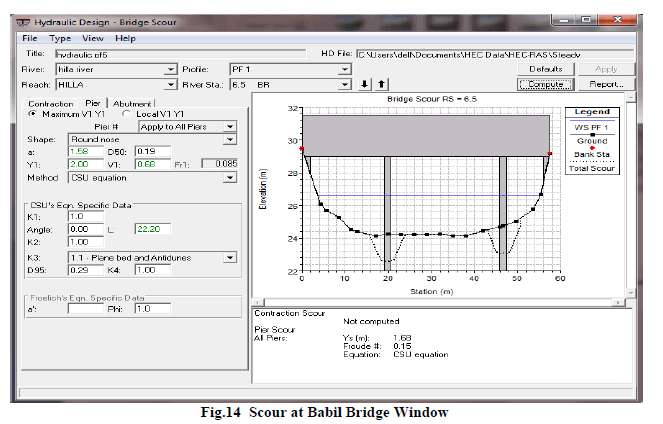 |
XIV. CONCLUSIONS |
| In this research, when the discharge equal to (70 m3/s) the maximum local scour depth that measured was found equal to (1.43m) and the evaluated maximum local scour depth is (1.68m) at Babil Bridge piers by HEC-RAS program. The difference between the computed and measured local scour depth showed that the HEC-RAS model is a good tool for predicting local scour for bridge piers. Hence, it could be used to determine the type of bridge pier foundations before constructing. The study showed that the piers of Babil Bridge is safe against scouring because the depth of the equilibrium scour is less than the depth of foundation of the bridge. The scouring around the piers should be evaluated from time to time because the local scour could be a major cause of bridge failures which the hydraulic conditions may change.a |
References |
|